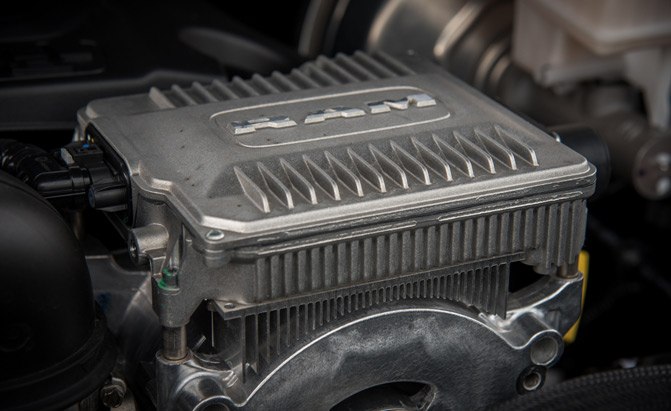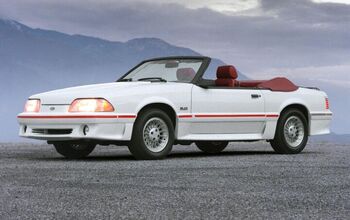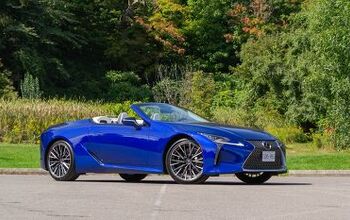10 Best Vehicle and Technology Innovations of 2018

Automobiles are much more than just an engine, transmission, interior and tires. They are full of the latest technology and incredible innovations that make vehicles smarter, more efficient and safer.
We applaud every manufacturer’s efforts to improve their vehicles, but some innovations really stand out from the crowd. AutoGuide.com has compiled a list of the 10 of the best innovations from this year that you might find on your next new car. Here are the 10 Best Vehicle and Technology Innovations of 2018, in no particular order.
GMC Sierra MultiPro Tailgate

Standard on Denali and AT4 trims, the MultiPro tailgate is a six-way adjustable tailgate. It can function as a normal gate, a tailgate step and even fold out of the way so you can walk an ATV all the way up into the bed on ramps. You can use it as a standing work table, set it up to work as a load stop, or just use it to simply get easier access to the bed.
GMC said it has been working on it for years, testing it more than any tailgate in the history of the company. It needs to be able to hold up in extreme conditions, and GMC says it will.
It’s also a no-brainer tailgate. Once you use it, you wonder why no one else has made a tailgate this versatile. It’s also impressive because truck tailgates haven’t seen a big innovation like this in years, so this is a big step forward.
READ MORE: 2019 GMC Sierra Denali Review
Hyundai Santa Fe Rear Occupant Alert

Several automakers have incorporated a rear occupant reminder system to let the driver know to check the rear seats. Children and pets die every year being left in hot cars, making these reminders a welcome addition to a car’s technology. Most cars with this system will give an audible reminder and a message in the dashboard to check the back seats. But many people learn to tune it out.
Unlike most reminder systems, Hyundai’s is different in the Santa Fe. It uses interior motion sensors to detect movement. If a driver becomes used to the rear seat alert and ignores it, the Hyundai system also looks for movement in the cabin. Up to 24 hours after the driver has left the vehicle, if the Santa Fe detects movement, it’ll send a notification through the Blue Link app, send an email to the owner, and honk the horn.
This extra level of security is why Hyundai’s system gets special recognition above and beyond the systems other manufacturers offer. This is not a gimmick — it’s a tangible technology that will actually save lives.
READ MORE: 2019 Hyundai Santa Fe Review
Hyundai Santa Fe Safe Exit Assist

Hyundai’s Santa Fe makes the list again for a great safety feature that also incorporates technology already built into the car.
If you attempt to unlock the rear child locks and there is a car or bicycle approaching from either the driver or passenger side of the vehicle, the car will prevent you from unlocking the child lock and the child opening the door. It’ll then show a warning in the cluster and sound an alert.
If the child unlock is already unlocked, but someone opens the door with an approaching car, the cluster will notify the driver and an alert tone will be heard. This helps keep passengers safe, but also ensures a cyclist doesn’t get doored.
The system utilizes the blind spot monitoring system, and we’ve been told by Hyundai it’ll also work if the ignition isn’t running on the vehicle. Audi has a similar system, but it’s impressive that it’s available on a mainstream, affordable vehicle like the Hyundai Santa Fe.
Jeep and Ram Trucks eTorque

FCA is offering its eTorque assist system on a growing number of products from Jeep and Ram Trucks. This system is a mild hybrid designed to both improve performance and efficiency in a clever way.
The vehicle’s alternator is removed and replaced with a 48-volt generator. The generator restarts the gasoline motor when the automatic start-stop system is used and it assists the engine as a hybrid setup.
It promises smoother shifts, smoother start-stop usage, and increased power and torque. For example, on the V8 Ram 1500 with eTorque, the system adds 130 lb-ft of torque to the truck. That’s performance you can feel.
READ MORE: 2019 Ram 1500 eTorque Review
The system is attached to the base V6 on the Ram 1500 and an optional upgrade on the V8. On the Jeep Wrangler, it’s attached to the upgraded 4-cylinder turbo. It’s also on the 4-cylinder turbo upgrade for the Cherokee.
It’s smart, it’s efficient, and it just works. Many automakers including Mercedes, Volkswagen, and Audi are introducing similar mild hybrid setups to their vehicles.
Audi A8’s Active Suspension

The Audi A8 has an active suspension like most luxury cars on the market that can be tailored for sportier or more comfortable driving dynamics. But we like to highlight technology that’s repurposed for something else, and the A8’s active suspension does something to improve safety in a crash.
If the car believes it’s about to be hit from the side, the suspension quickly raises the side of the car that’s about to be hit. The system acts in half a second and raises the side by 80 millimeters if it detects a collision faster than 25 km/h.
ALSO SEE: 2019 Audi A8 Review
The reason? The vehicle about to crash into you will hit the stiffer components of the vehicle designed to handle a crash. As vehicles get taller, thanks to crossovers and SUVs, this system could make a significant difference in preserving life and preventing injuries.
BMW’s Wireless Electric Car Charging System

Your smartphone has it. Your smartwatch has it. Your electric toothbrush even has it. It’s wireless charging, and it’s something that really hasn’t been expanded to electric vehicles yet.
BMW is about to change that with its wireless charging pad for electric vehicles. Instead of pulling into your garage, getting out and plugging in a cord, you just drive overtop the charging pad and go about your day.
It’s only a pilot program in the United States, but it’s hard to imagine that it’d remain that way for long. Wireless charging is both convenient and easy, ensuring you have all the electric mileage you need when you start your drive.
Nissan and Infiniti’s VC-Turbo

Explaining how Nissan’s variable compression ratio turbo works would cause many readers’ eyes to glaze over, but the fact is the technology is high-tech and one of the biggest advancements to the internal combustion engine.
Currently found in the Infiniti QX50 and coming to the Nissan Altima, the VC-Turbo engine can adjust its compression ratio on the fly. The system can choose one ratio for driving fuel efficiently, then at the touch of the throttle, the system can instantaneously adjust to a higher ratio for performance driving. It’s seamless when it makes the adjustment and doesn’t require any input from the driver.
This engine is a way that drivers can have both fuel efficiency and performance, the best of both worlds, without too much sacrifice. Expect to see it on more Nissan and Infiniti products in the future.
ALSO SEE: 2019 Infiniti QX50 Review
Subaru Forester DriverFocus

Making sure the driver is paying attention to the road is key for semi-autonomous driving systems and also reducing crashes. Subaru’s new DriverFocus technology in the new Forester makes most other systems look dated.
Unlike most systems that use a torque sensor in the steering wheel waiting for steering input from the driver, the DriverFocus system uses infrared facial recognition technology. It watches your face to see if you’re distracted or if you’re falling asleep and then if it sees you’re not focused on driving, it will give you audible and visual warnings. It also works with the EyeSight system to preload the automatic emergency braking if it senses an impending collision.
Additionally, since the car can identify your face, it can identify you and load your custom settings when you get in the car. That means your HVAC settings and more are automatically recovered when you need it.
The system recognizes up to five drivers, too. That means you and your entire family get the cool memory features, but also the added safety.
READ MORE: 2019 Subaru Forester Review
Cadillac Super Cruise

Available on the top-tier CT6 luxury sedan, Super Cruise is the most advanced Level 2 semi-autonomous driving aid on the planet.
By using a camera facing the driver and digitally mapped highway information, the driving aid lets the driver completely remove their hands form the steering wheel. All other systems, including Tesla’s Autopilot, require the driver’s hand on the wheel.
READ MORE: Cadillac Super Cruise is Really Good, but Far From Perfect
Additionally, Super Cruise will bring the car to a full stop, and at the request of the driver perform lane changes. Because you can take your hands off the wheel doesn’t mean you don’t have to pay attention. The camera makes sure you’re watching ahead, ready to take over if necessary, and will disable if it notices you aren’t paying attention.
It’s a $5,000 premium over a top-tier CT6, but if you do a lot of highway traveling, you’ll appreciate the tech. The technology is only available in the CT6 currently, but it will eventually roll out to other GM models in 2020.
Mercedes’ New MBUX Infotainment

Mercedes-Benz’s infotainment received a big upgrade this year. Soon to be featured across the line, including the new A-Class sedan, the next-generation MBUX system is a leap forward.
Two giant screens make up the infotainment screen and instrument cluster with the infotainment screen being a touchscreen. If you don’t like using the new touch-based controller, you can just touch the screen. That alone makes it more intuitive.
It also responds to voice commands like Apple’s Siri or Amazon’s Alexa. Just say, “Hey Mercedes,” along with your command it’ll respond. Because the car is connected, it can even respond to commands like asking for the weather forecast. The voice prompts are also pretty intuitive.
Like the systems on our phones and in our homes, the MBUX system learns over time, becoming more useful the more you use it. It’s interesting that Mercedes decided to roll out its own solution instead of licensing another product, but it’s connectivity that we expect to see from more OEMs in the future. It’s also amazing that it’s debuting on an accessible car like the A-Class too, and not a hugely expensive car that only a handful of people can experience.
READ MORE: 2019 Mercedes A-Class Review
More by Chad Kirchner































Comments
Join the conversation